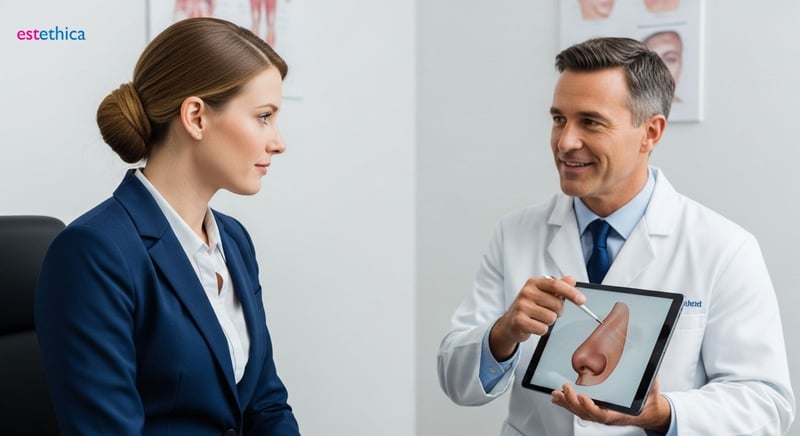Rhinoplasty: Sculpting Confidence Through Nose Surgery
Nose surgery and rhinoplasty: redefining beauty and functionality with estethica. Choose the best approach for your needs today.
Nose surgery, or rhinoplasty, offers a transformative journey to enhance not only your facial aesthetics but also your confidence and breathing functionality. From correcting nasal asymmetry to resolving functional issues like a deviated septum, rhinoplasty is more than just cosmetic enhancement.
Understanding Rhinoplasty: More Than Just Cosmetic Nose Surgery
Exploring the Functional Benefits of Nose Surgery
Rhinoplasty, often perceived as primarily a cosmetic procedure, extends far beyond mere aesthetic enhancements. While it's true that a nose job can dramatically improve facial symmetry and boost self-confidence, its functional benefits are equally significant. Many individuals seek rhinoplasty to correct structural issues that impede breathing, such as a deviated septum or nasal valve collapse. This highlights the crucial role of nose surgery in not only refining appearance but also enhancing overall quality of life by improving nasal functionality.
- Improved Breathing: Corrects structural issues like deviated septums.
- Sinus Relief: Addresses chronic congestion linked to nasal structure.
- Enhanced Sleep Quality: Reduces snoring and sleep apnea symptoms.
The impact of rhinoplasty on breathing can be transformative. For example, a patient with a long-standing deviated septum who undergoes deviated septum surgery combined with cosmetic nose surgery might experience a significant reduction in sinus infections. Nasal reshaping through rhinoplasty can also alleviate chronic congestion, leading to better sleep and increased energy levels. The blend of cosmetic and functional improvements makes rhinoplasty a versatile solution for those seeking both aesthetic and health benefits. Understanding these dual benefits is crucial for anyone considering nose surgery.
Rhinoplasty Techniques and Their Impact
The field of rhinoplasty encompasses a range of techniques tailored to meet individual needs, from subtle refinements to comprehensive structural corrections. Open rhinoplasty involves a small incision across the columella, allowing the surgeon extensive access to reshape the underlying bone and cartilage. Closed rhinoplasty, on the other hand, is performed entirely through the nostrils, minimizing external scarring. The choice between open vs closed rhinoplasty depends on the complexity of the required corrections and the surgeon's expertise.
- Pre-Surgical Assessment: Detailed evaluation of nasal structure.
- Surgical Technique Selection: Choosing open or closed approach.
- Post-Operative Care: Managing swelling and ensuring proper healing.
Rhinoplasty techniques also extend to non-surgical options, such as liquid rhinoplasty, which uses injectable fillers to temporarily reshape the nose. While non surgical nose job options offer a less invasive alternative, they are best suited for minor adjustments and lack the permanence of surgical nasal reconstruction. Regardless of the technique, the goal of rhinoplasty is to achieve a harmonious balance between aesthetic appeal and functional improvement, enhancing both the appearance and the well-being of the patient. For those seeking a best rhinoplasty surgeon near me, understanding these options is key to making an informed decision.

Open vs. Closed Rhinoplasty: Choosing the Right Approach for You
Understanding the Surgical Approaches in Nose Surgery
When considering rhinoplasty, understanding the difference between open and closed techniques is crucial. Open rhinoplasty involves lifting the nasal skin to provide the surgeon with better visibility and precision, often used for major reshaping. In contrast, closed rhinoplasty offers a less invasive option, with all incisions made within the nostrils, ideal for minor adjustments. The choice depends on the complexity of the reshaping required, recovery time considerations, and personal preferences. Both approaches aim to enhance nasal aesthetics and function, but they differ significantly in surgical execution and recovery expectations.
- Open Rhinoplasty: Provides greater surgical access for complex corrections.
- Closed Rhinoplasty: Minimizes external scarring with internal incisions.
- Individualized Approach: Tailored to meet specific patient needs and goals.
For instance, a patient seeking significant nasal reconstruction due to a previous injury might benefit more from the open approach, allowing for extensive structural modifications. Conversely, someone desiring a subtle refinement of the nasal tip might find closed rhinoplasty sufficient. The decision-making process involves a thorough consultation with a skilled surgeon who can assess the nasal anatomy and recommend the most appropriate technique. Whether it's addressing breathing issues or enhancing cosmetic appearance, the chosen approach plays a pivotal role in achieving the desired outcome. Additionally, techniques like liquid nose job and ethnic rhinoplasty can influence the choice between open and closed methods, ensuring a personalized treatment plan.
Factors Influencing the Choice of Rhinoplasty Technique
The selection between open and closed rhinoplasty is influenced by several factors, including the patient's specific anatomical needs, the extent of the desired changes, and the surgeon's expertise. Open rhinoplasty is often preferred for complex cases involving significant nasal reshaping, such as correcting a severely deviated septum or reconstructing the nose after trauma. This technique allows the surgeon to directly visualize and manipulate the underlying structures, ensuring precise and predictable results. On the other hand, closed rhinoplasty is suitable for patients seeking minor adjustments with minimal downtime. This approach involves making incisions inside the nostrils, resulting in no visible external scars.
- Complexity of Correction: Open for major, closed for minor adjustments.
- Surgeon's Expertise: Influences technique selection and outcomes.
- Patient Preferences: Considering recovery time and scarring concerns.
For example, individuals exploring rhinoplasty for breathing problems may require the open approach to effectively address structural issues like nasal valve collapse. Conversely, those interested in a non surgical nose job options or slight cosmetic enhancements might opt for closed rhinoplasty to avoid extensive surgery. Ultimately, the best approach is determined through a comprehensive evaluation and discussion with a qualified rhinoplasty surgeon. Understanding the nuances of each technique empowers patients to make informed decisions and achieve their desired results. Whether considering male rhinoplasty or revision rhinoplasty, the chosen technique should align with the patient's goals and anatomical requirements.

Rhinoplasty for Breathing Problems: Correcting Deviated Septum and More
The Role of Septoplasty in Enhancing Nasal Function
Rhinoplasty is often sought to improve nasal aesthetics, it also plays a crucial role in correcting functional issues, particularly those related to breathing. A common problem is a deviated septum, where the cartilage dividing the nasal passages is displaced, leading to obstructed airflow. In such cases, a procedure called septoplasty is often performed in conjunction with nose surgery to straighten the septum, alleviating breathing difficulties. This combination not only enhances the nose's appearance but also significantly improves the patient's respiratory function. For instance, individuals experiencing chronic sinusitis or nasal congestion due to a deviated septum may find considerable relief through this combined approach.
- Improved Airflow: Straightening the septum enhances breathing.
- Sinus Relief: Corrects structural issues causing congestion.
- Better Sleep: Reduces snoring and sleep apnea symptoms.
Integrating septoplasty with rhinoplasty ensures that both cosmetic and functional goals are addressed simultaneously. For example, a patient undergoing cosmetic nose surgery to refine the nasal tip might also opt to correct a minor septal deviation to improve airflow. This comprehensive approach maximizes the benefits of nose surgery, leading to enhanced overall satisfaction. Moreover, addressing breathing issues through deviated septum surgery can have a positive impact on overall health, reducing the likelihood of sinus infections and improving sleep quality. The integration of septoplasty and rhinoplasty exemplifies how modern surgical techniques can provide both aesthetic and functional improvements, enhancing the patient's quality of life. Patients also consider liquid nose job or ethnic rhinoplasty options for comprehensive nasal care.
Benefits of Rhinoplasty for Nasal Obstruction
Rhinoplasty offers numerous benefits beyond cosmetic enhancement, particularly for individuals suffering from nasal obstruction. Functional nose surgery can address various structural issues, such as nasal valve collapse, turbinate hypertrophy, and a deviated septum, all of which can impede airflow. By correcting these problems, rhinoplasty can significantly improve breathing, reduce snoring, and alleviate symptoms of sleep apnea. For example, patients who have struggled with chronic nasal congestion and difficulty breathing through their nose may experience a dramatic improvement in their quality of life after undergoing functional rhinoplasty.
- Diagnosis: Identify structural issues causing obstruction.
- Surgical Correction: Correct deviated septum or nasal valve collapse.
- Post-Op Care: Ensure proper healing and optimal airflow.
Consider a patient who has a history of nasal trauma resulting in a deviated septum and nasal asymmetry. In this case, rhinoplasty can be performed to straighten the septum, reconstruct the nasal passages, and improve overall nasal symmetry. Another example is someone with enlarged turbinates, which can be reduced during nose surgery to create more space for airflow. Furthermore, rhinoplasty can be combined with other procedures, such as sinus surgery, to address related issues and provide comprehensive relief. The goal is to restore optimal nasal function while also achieving a more aesthetically pleasing appearance. Whether considering open vs closed rhinoplasty or seeking a best rhinoplasty surgeon near me, understanding the functional benefits is key. The combined approach of cosmetic nose surgery and functional correction ensures patients receive comprehensive care, addressing both aesthetic and health concerns. Patients often explore options like non surgical nose job options for minor breathing improvements.

Beyond the Procedure: Rhinoplasty Recovery Tips for Optimal Results
Essential Aftercare Steps Following Nose Surgery
Achieving the best possible outcome from rhinoplasty involves more than just the surgical procedure itself; it requires diligent aftercare. The initial days and weeks following nose surgery are crucial for ensuring proper healing and minimizing complications. Patients must manage swelling, protect the nasal structure, and adhere to their surgeon's specific instructions. Neglecting these aftercare steps can compromise the results of the nose job and potentially necessitate revision surgery. Proper aftercare not only supports the healing process but also contributes significantly to the long-term success and satisfaction with the rhinoplasty.
- Minimize Swelling: Apply cold compresses and keep head elevated.
- Protect Nasal Structure: Avoid strenuous activities and trauma.
- Follow Instructions: Adhere to surgeon's medication and care guidelines.
For instance, patients are typically advised to avoid blowing their nose for several weeks to prevent disruption of the healing tissues. Instead, gentle nasal irrigation with saline solution is recommended to keep the nasal passages clear. Another crucial aspect is avoiding strenuous activities that could increase blood pressure and cause swelling or bleeding. Simple actions like these can make a significant difference in the recovery process. Patients who follow their surgeon's aftercare instructions diligently are more likely to experience a smooth recovery and achieve the desired aesthetic and functional outcomes from their rhinoplasty. For those considering ethnic rhinoplasty or liquid nose job, understanding the aftercare is just as important as the procedure itself. Remember, the success of your nose surgery is a partnership between you and your surgeon.
Optimizing Recovery and Preventing Complications After Rhinoplasty
To ensure a smooth and successful recovery after rhinoplasty, it is essential to follow specific guidelines that optimize healing and minimize the risk of complications. One of the most important steps is to keep the head elevated, especially during sleep, to reduce swelling and promote drainage. Patients should also avoid wearing glasses or anything that puts pressure on the nose for several weeks. Proper hydration and a healthy diet are also crucial for supporting the body's natural healing processes. By taking these precautions, patients can significantly improve their recovery experience and achieve the best possible results from their nose surgery.
- Elevate Head: Reduce swelling and promote drainage.
- Avoid Pressure: Protect nasal structure from external forces.
- Stay Hydrated: Support body's natural healing processes.
Consider a patient who undergoes a deviated septum surgery combined with cosmetic nose surgery. Following the surgeon's advice to avoid strenuous exercise and contact sports is crucial to prevent any trauma to the newly corrected nasal structure. Another example is a patient who uses saline nasal sprays regularly to keep the nasal passages moist and prevent crusting. These measures not only promote healing but also reduce the risk of infection. Additionally, attending all follow-up appointments with the surgeon is vital for monitoring progress and addressing any concerns promptly. Whether it's open vs closed rhinoplasty or a non surgical nose job options, diligent aftercare is a key factor in achieving optimal outcomes and preventing complications. Patients seeking a best rhinoplasty surgeon near me should also inquire about their post-operative care protocols to ensure comprehensive support throughout the recovery process. Remember, the goal is to ensure a successful and satisfying outcome from your rhinoplasty experience.
Precision Rhinoplasty with Open and Closed Techniques for Functional and Aesthetic Results
estethica employs both open and closed rhinoplasty techniques, tailoring the approach to each patient's unique needs. Open rhinoplasty provides enhanced visibility for complex nasal reshaping, while closed rhinoplasty minimizes external scarring through internal incisions, ensuring personalized treatment plans.
estethica’s rhinoplasty surgeons possess extensive experience in both cosmetic and functional nasal surgery, addressing deviated septums, nasal valve collapse, and other structural issues. Their expertise extends to non-surgical options like liquid rhinoplasty for minor adjustments, ensuring comprehensive care.
Comprehensive Rhinoplasty Aftercare for Optimal Healing and Long-Term Satisfaction
estethica emphasizes diligent aftercare following rhinoplasty, providing patients with detailed instructions to minimize swelling and protect the nasal structure. Patients receive guidance on managing swelling with cold compresses, avoiding strenuous activities, and gentle nasal irrigation to ensure proper healing.
estethica's commitment to patient safety and health is evident in its comprehensive approach to rhinoplasty, combining aesthetic enhancement with functional correction. The hospital's focus on clear communication and personalized care ensures patients are well-informed and supported throughout their rhinoplasty journey, leading to high satisfaction.
Frequently Asked Questions
What is rhinoplasty and what are its benefits?
What is the difference between open and closed rhinoplasty?
Can rhinoplasty help with breathing problems?
What is septoplasty and how does it relate to rhinoplasty?
What is the recovery process like after rhinoplasty?
Ready to discover your healthiest, most beautiful self with estethica's world-class aesthetic and healthcare services?
📞 Book Your Free Consultation Now!